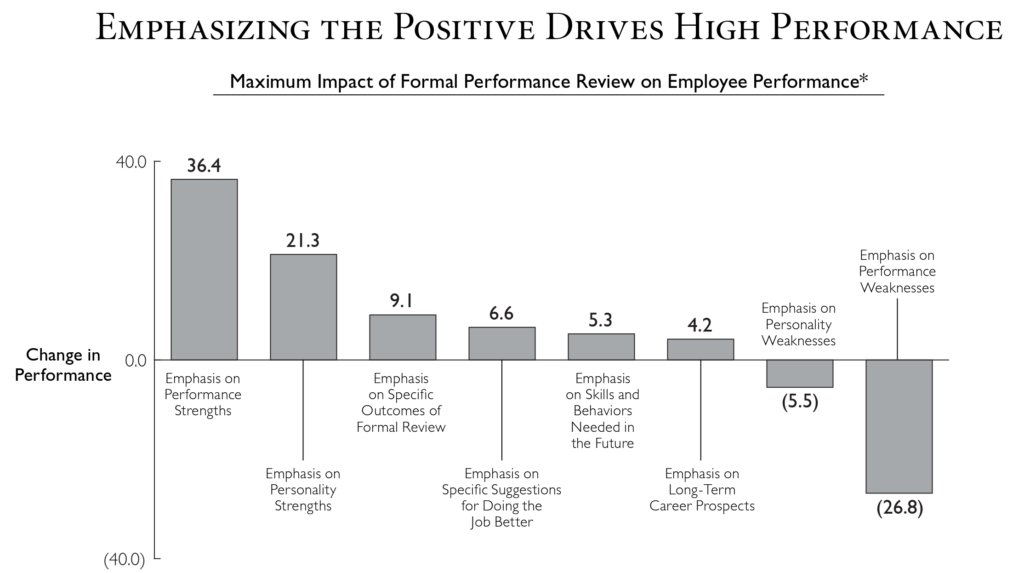
Why Focus on Strengths?
Most performance reviews look something like this: an overview of successes for the year, followed by areas for improvement going forward. In other words, a team member and their leader celebrate accomplishments, but they also take a deficit-based approach, focusing time and attention on determining what needs to be fixed and how to fix it and making weaknesses the focus of developmental plans.A strengths-based approach, by contrast, focuses primarily on identifying and developing a person’s strengths (rather than surfacing weaknesses) as the pathway to performance improvement. “A strengths-based performance appraisal does not imply that performance problems can no longer be discussed or that supervisors can only be positive. It does however mean that the supervisor makes an effort to discover the unique qualities of employees and to maximize the opportunity for employees to carry out work activities in a manner that plays to their strengths.” (The Effect of Strengths-Based Performance Appraisal on Perceived Supervisor Support and the Motivation to Improve Performance, Marianne van Woerkom and Brigitte Kroon, Frontiers in Psychology, July 31, 2020.)
Focusing on Strengths Produces Greater Engagement and Retention.
A Gallup analysis reveals that, in a strengths-based culture, people are three times more likely to report having an excellent quality of life, six times more likely to be engaged at work, and 15% less likely to quit their jobs.Professional development is a key factor in retention, and it is not achieved through more training sessions. Rather, it is the result of intensive one-on-one coaching in which our leaders strive to authentically understand the people on their team and facilitate their unique contributions.
It all begins with a strengths inventory, which is now an essential element of the Silverchair performance management process. Starting with our 2021 end-of-year reviews, leaders of people are now guided through prompts designed to inform a deeper understanding of each person’s strengths. Empowered by this understanding, our people can have transformative onversations regarding how to cultivate, amplify, and leverage individual strengths in the context of our work.
Strengths-Based Appraisals Unlock Higher Performance.
Focusing on strengths (rather than weakness) also leads to higher performance. A 2002 study from the Corporate Leadership Council found that organizations that focus on strengths in the appraisal process increase performance by 36.4%, whereas organizations that emphasize weakness reduce their performance by 26.8%.Subsequent research has validated this study. According to a 2020 paper published in Frontiers in Psychology, taking a strengths-based approach to performance reviews is strongly correlated with the motivation to improve. Focusing on future possibilities grounded in what someone does well rather than on dissecting the deficiencies of the past is most likely to lead to performance improvement. This also short-circuits the reflex to craft developmental goals that are focused on remediating weaknesses rather than leveraging what a person already tends to do very well.

There is such a thing as being ill-suited for a job. In the vast majority of cases, however, a job can be done well in multiple different ways. Effective developmental leaders are able to “see the raw material for brilliance in every employee and create the conditions to let it shine, even when the challenge is tough.” (How to Give Tough Feedback That Helps People Grow, Monique Valcour, Harvard Business Review, August 11, 2015.)
Few things more alienating than being assigned objectives without any regard to how you are uniquely equipped to accomplish them. This is part of why performance reviews typically elicit dread rather than inspiration. We feel judged by generic standards and left with no emotional connection to what it is we are being asked to achieve. The ultimate tool for engaging and motivating people is to find the elusive sweet spot at the intersection of their innate skills, interests, and passions and what the organization most needs. In the process, people feel seen and appreciated, their performance naturally improves, and the organization thrives.
Ultimately, taking a strengths-based approach to performance reviews grounds us in the unique potential of our people rather than a registry of how they have fallen short. The result is vastly improved satisfaction and performance and, for each of us as individuals, a deeper sense of satisfaction and purpose in our work.
So, what has this meant for Silverchair?
At the conclusion of our 2021 Annual Review process - the first to employ this approach - our team circulated a survey to gain insights into what worked well and what we should refine. We then validated these results by asking our communities of practice for further feedback from role groups, and we followed up with our people leaders.On the substance side, we suspended our complex four-level rating scale and opted for two designations: “on-track” and “off-track.” We did this deliberately to remove the "grade" from the equation and make our people more likely to focus on the qualitative data regarding how someone is faring.
Overwhelmingly, Silverchairians said we should maintain an on/off track rating system as long as:
- one-on-one check-ins with people managers are consistent and meaningful;
- the review process also includes a prompt explicitly soliciting critical feedback and growth opportunities; and
- We offer an alternative way to acknowledge and reward exceptionally high performance in a particular year as well as identifying who is promotion-ready.
As we initiate our 2022 Mid-Year Review process, we recommit to building a culture that is focused on bringing out the best in each person and supplying the development necessary to support the achievement of that unique potential. We have great confidence that our strengths-based approach to reviews will continue to produce higher quality feedback, more meaningful development, and yet greater success for our people and our business.